Business Models, Structure, and PESTLE Analysis Report
VerifiedAdded on 2022/11/30
|11
|2314
|95
Report
AI Summary
This report provides a comprehensive overview of different business types, including micro, small, medium, and large businesses, along with their characteristics. It defines various business structures such as sole trader, partnership, limited liability, public limited liability, and cooperative, detailing their key features. The report further explores different organizational structures, such as hierarchical, functional, and divisional structures, and explains how these structures impact business productivity. A significant portion of the report is dedicated to PESTLE analysis, emphasizing its importance in understanding external factors affecting an organization. The report includes a PESTLE analysis of Tesco, a major retail company, examining the political, economic, social, technological, environmental, and legislative factors influencing its operations and strategies. The analysis highlights how these factors affect Tesco's business environment and strategic decision-making, providing a practical application of the PESTLE framework.
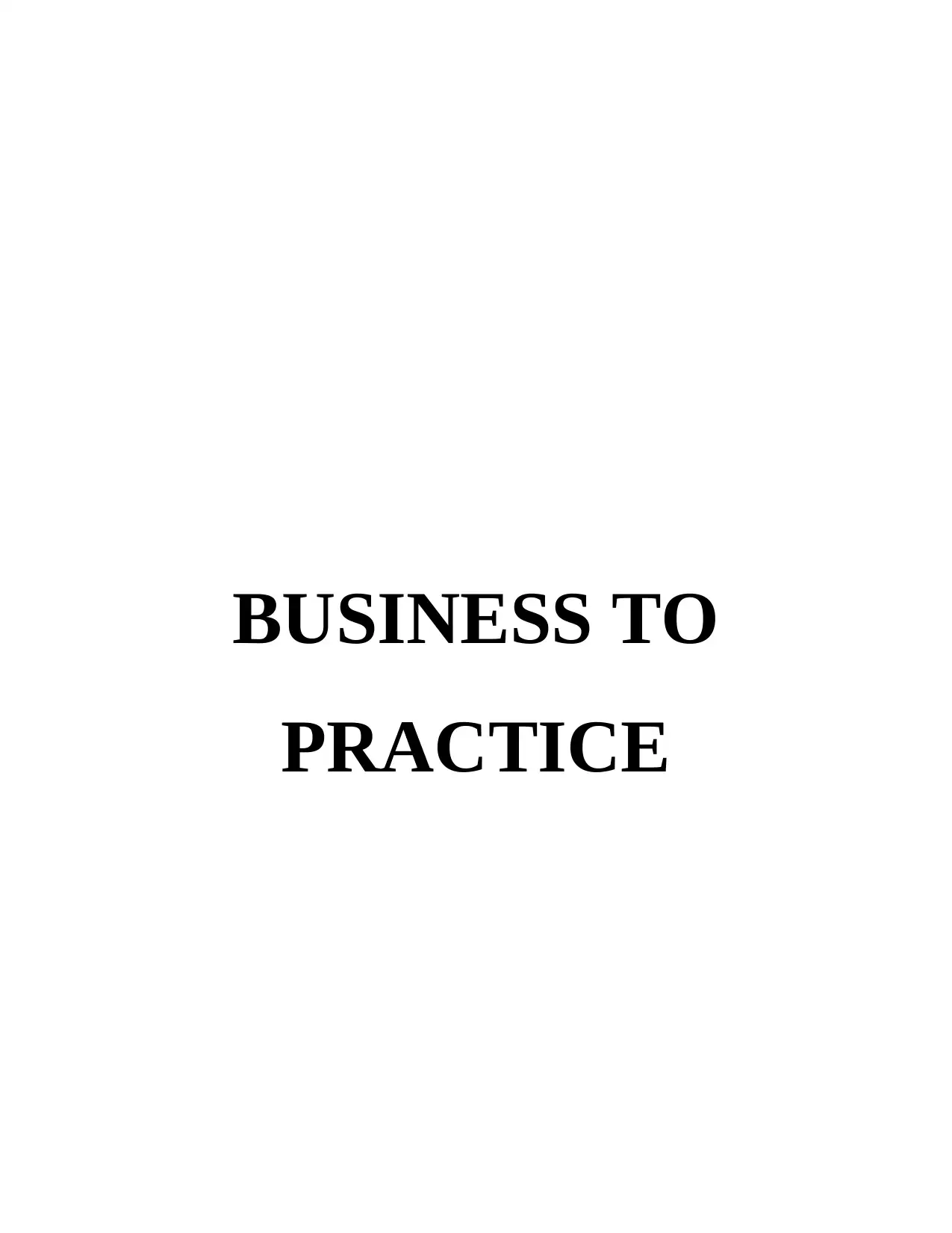
BUSINESS TO
PRACTICE
PRACTICE
Paraphrase This Document
Need a fresh take? Get an instant paraphrase of this document with our AI Paraphraser
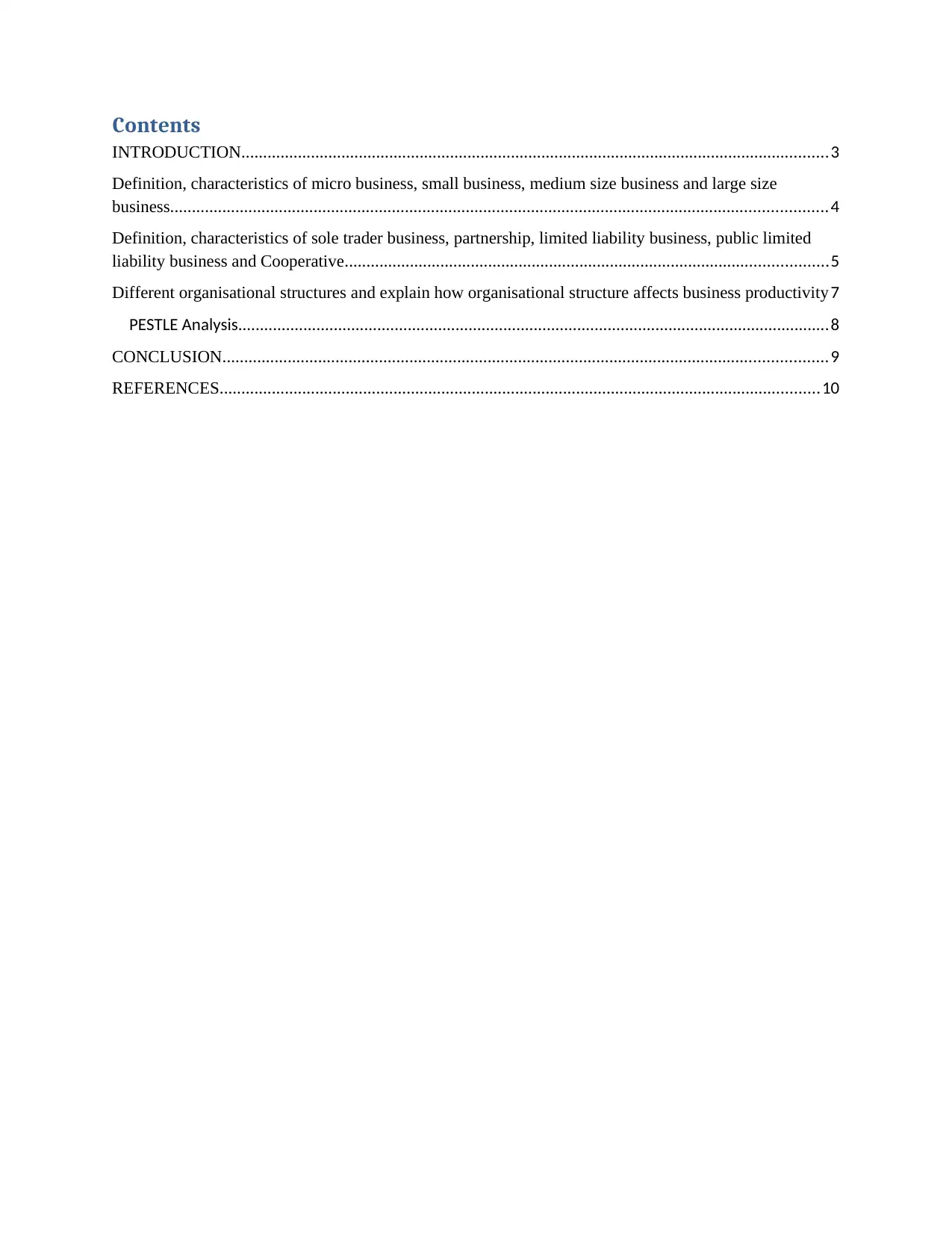
Contents
INTRODUCTION.......................................................................................................................................3
Definition, characteristics of micro business, small business, medium size business and large size
business.......................................................................................................................................................4
Definition, characteristics of sole trader business, partnership, limited liability business, public limited
liability business and Cooperative...............................................................................................................5
Different organisational structures and explain how organisational structure affects business productivity 7
PESTLE Analysis........................................................................................................................................8
CONCLUSION...........................................................................................................................................9
REFERENCES..........................................................................................................................................10
INTRODUCTION.......................................................................................................................................3
Definition, characteristics of micro business, small business, medium size business and large size
business.......................................................................................................................................................4
Definition, characteristics of sole trader business, partnership, limited liability business, public limited
liability business and Cooperative...............................................................................................................5
Different organisational structures and explain how organisational structure affects business productivity 7
PESTLE Analysis........................................................................................................................................8
CONCLUSION...........................................................................................................................................9
REFERENCES..........................................................................................................................................10
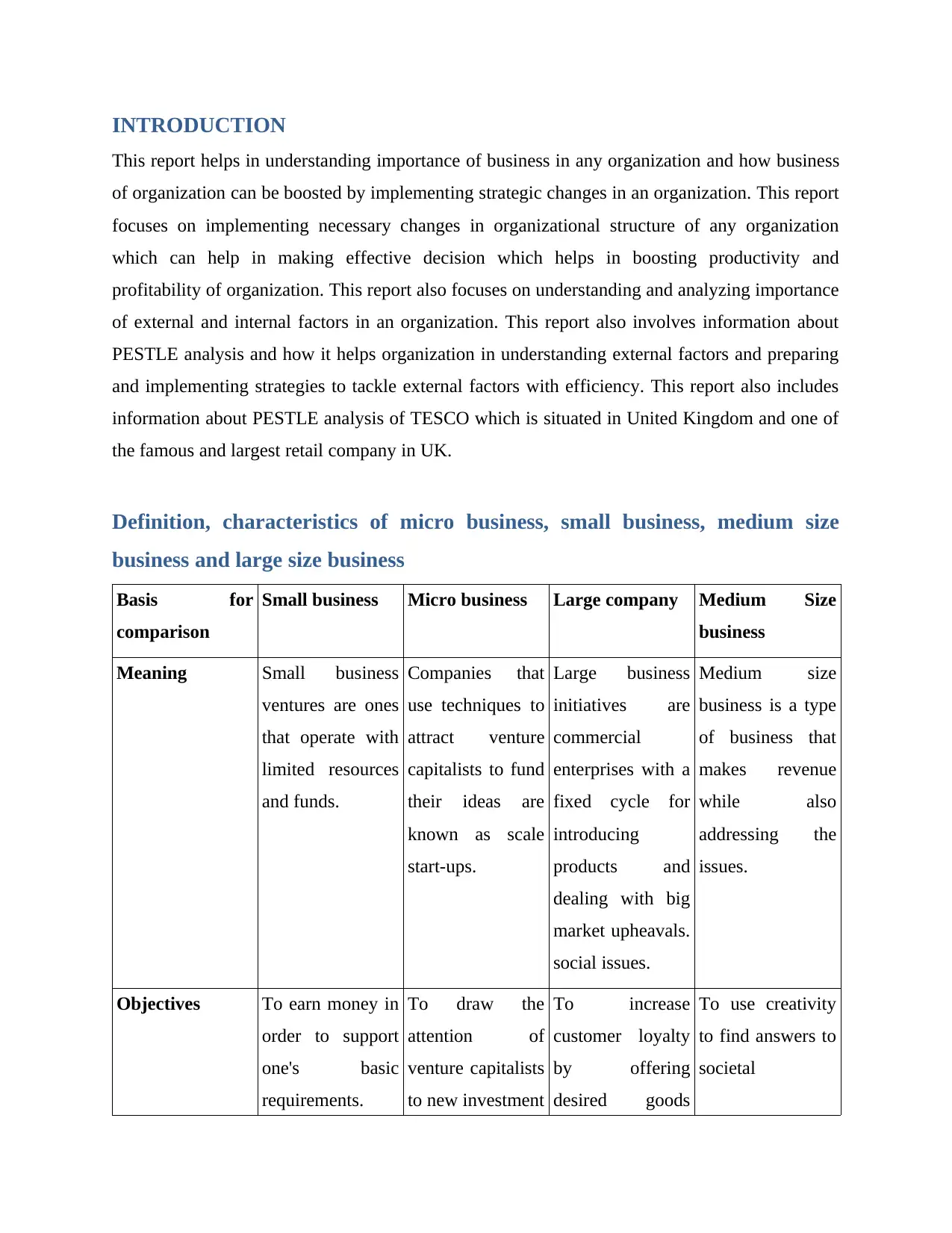
INTRODUCTION
This report helps in understanding importance of business in any organization and how business
of organization can be boosted by implementing strategic changes in an organization. This report
focuses on implementing necessary changes in organizational structure of any organization
which can help in making effective decision which helps in boosting productivity and
profitability of organization. This report also focuses on understanding and analyzing importance
of external and internal factors in an organization. This report also involves information about
PESTLE analysis and how it helps organization in understanding external factors and preparing
and implementing strategies to tackle external factors with efficiency. This report also includes
information about PESTLE analysis of TESCO which is situated in United Kingdom and one of
the famous and largest retail company in UK.
Definition, characteristics of micro business, small business, medium size
business and large size business
Basis for
comparison
Small business Micro business Large company Medium Size
business
Meaning Small business
ventures are ones
that operate with
limited resources
and funds.
Companies that
use techniques to
attract venture
capitalists to fund
their ideas are
known as scale
start-ups.
Large business
initiatives are
commercial
enterprises with a
fixed cycle for
introducing
products and
dealing with big
market upheavals.
social issues.
Medium size
business is a type
of business that
makes revenue
while also
addressing the
issues.
Objectives To earn money in
order to support
one's basic
requirements.
To draw the
attention of
venture capitalists
to new investment
To increase
customer loyalty
by offering
desired goods
To use creativity
to find answers to
societal
This report helps in understanding importance of business in any organization and how business
of organization can be boosted by implementing strategic changes in an organization. This report
focuses on implementing necessary changes in organizational structure of any organization
which can help in making effective decision which helps in boosting productivity and
profitability of organization. This report also focuses on understanding and analyzing importance
of external and internal factors in an organization. This report also involves information about
PESTLE analysis and how it helps organization in understanding external factors and preparing
and implementing strategies to tackle external factors with efficiency. This report also includes
information about PESTLE analysis of TESCO which is situated in United Kingdom and one of
the famous and largest retail company in UK.
Definition, characteristics of micro business, small business, medium size
business and large size business
Basis for
comparison
Small business Micro business Large company Medium Size
business
Meaning Small business
ventures are ones
that operate with
limited resources
and funds.
Companies that
use techniques to
attract venture
capitalists to fund
their ideas are
known as scale
start-ups.
Large business
initiatives are
commercial
enterprises with a
fixed cycle for
introducing
products and
dealing with big
market upheavals.
social issues.
Medium size
business is a type
of business that
makes revenue
while also
addressing the
issues.
Objectives To earn money in
order to support
one's basic
requirements.
To draw the
attention of
venture capitalists
to new investment
To increase
customer loyalty
by offering
desired goods
To use creativity
to find answers to
societal
⊘ This is a preview!⊘
Do you want full access?
Subscribe today to unlock all pages.

Trusted by 1+ million students worldwide
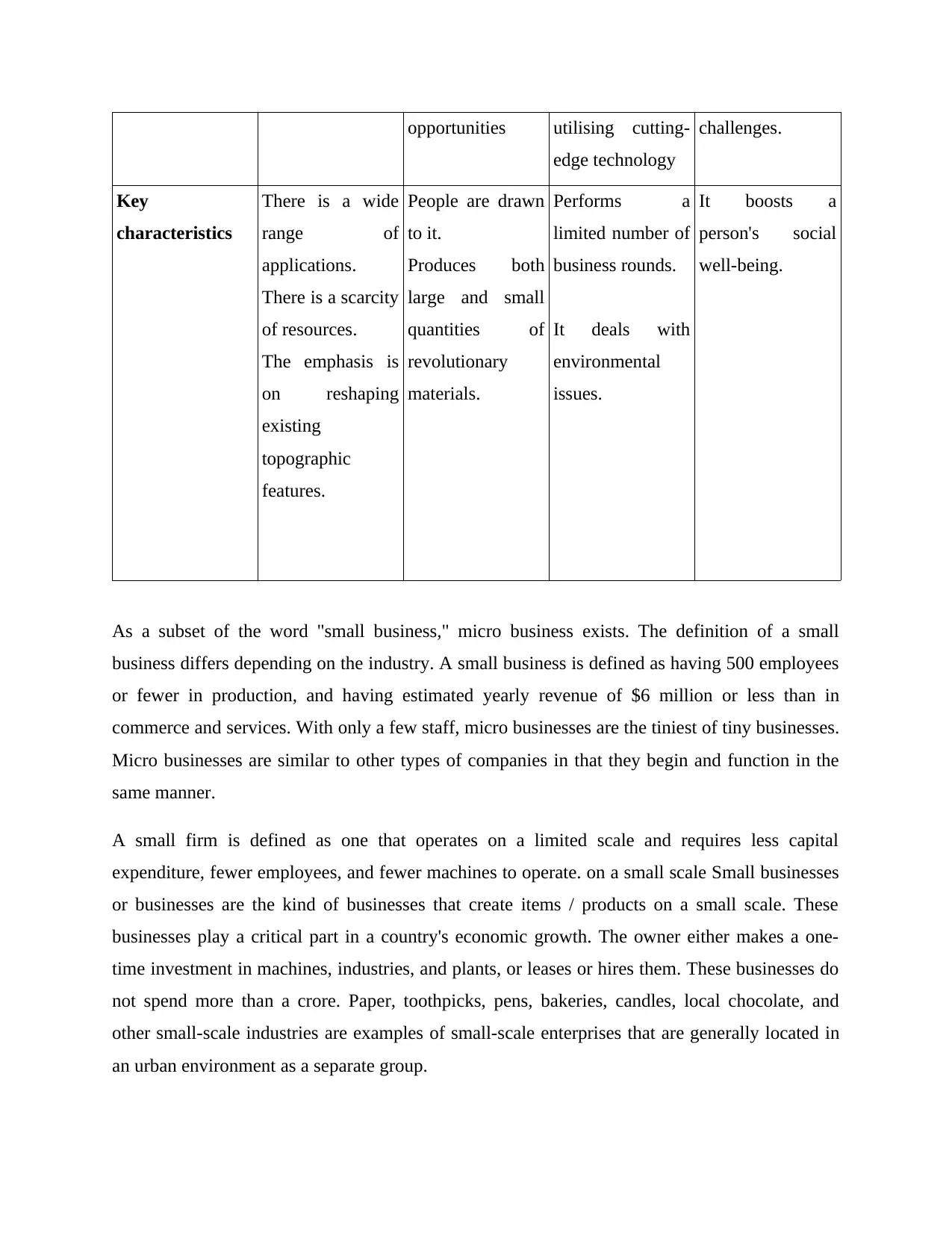
opportunities utilising cutting-
edge technology
challenges.
Key
characteristics
There is a wide
range of
applications.
There is a scarcity
of resources.
The emphasis is
on reshaping
existing
topographic
features.
People are drawn
to it.
Produces both
large and small
quantities of
revolutionary
materials.
Performs a
limited number of
business rounds.
It deals with
environmental
issues.
It boosts a
person's social
well-being.
As a subset of the word "small business," micro business exists. The definition of a small
business differs depending on the industry. A small business is defined as having 500 employees
or fewer in production, and having estimated yearly revenue of $6 million or less than in
commerce and services. With only a few staff, micro businesses are the tiniest of tiny businesses.
Micro businesses are similar to other types of companies in that they begin and function in the
same manner.
A small firm is defined as one that operates on a limited scale and requires less capital
expenditure, fewer employees, and fewer machines to operate. on a small scale Small businesses
or businesses are the kind of businesses that create items / products on a small scale. These
businesses play a critical part in a country's economic growth. The owner either makes a one-
time investment in machines, industries, and plants, or leases or hires them. These businesses do
not spend more than a crore. Paper, toothpicks, pens, bakeries, candles, local chocolate, and
other small-scale industries are examples of small-scale enterprises that are generally located in
an urban environment as a separate group.
edge technology
challenges.
Key
characteristics
There is a wide
range of
applications.
There is a scarcity
of resources.
The emphasis is
on reshaping
existing
topographic
features.
People are drawn
to it.
Produces both
large and small
quantities of
revolutionary
materials.
Performs a
limited number of
business rounds.
It deals with
environmental
issues.
It boosts a
person's social
well-being.
As a subset of the word "small business," micro business exists. The definition of a small
business differs depending on the industry. A small business is defined as having 500 employees
or fewer in production, and having estimated yearly revenue of $6 million or less than in
commerce and services. With only a few staff, micro businesses are the tiniest of tiny businesses.
Micro businesses are similar to other types of companies in that they begin and function in the
same manner.
A small firm is defined as one that operates on a limited scale and requires less capital
expenditure, fewer employees, and fewer machines to operate. on a small scale Small businesses
or businesses are the kind of businesses that create items / products on a small scale. These
businesses play a critical part in a country's economic growth. The owner either makes a one-
time investment in machines, industries, and plants, or leases or hires them. These businesses do
not spend more than a crore. Paper, toothpicks, pens, bakeries, candles, local chocolate, and
other small-scale industries are examples of small-scale enterprises that are generally located in
an urban environment as a separate group.
Paraphrase This Document
Need a fresh take? Get an instant paraphrase of this document with our AI Paraphraser
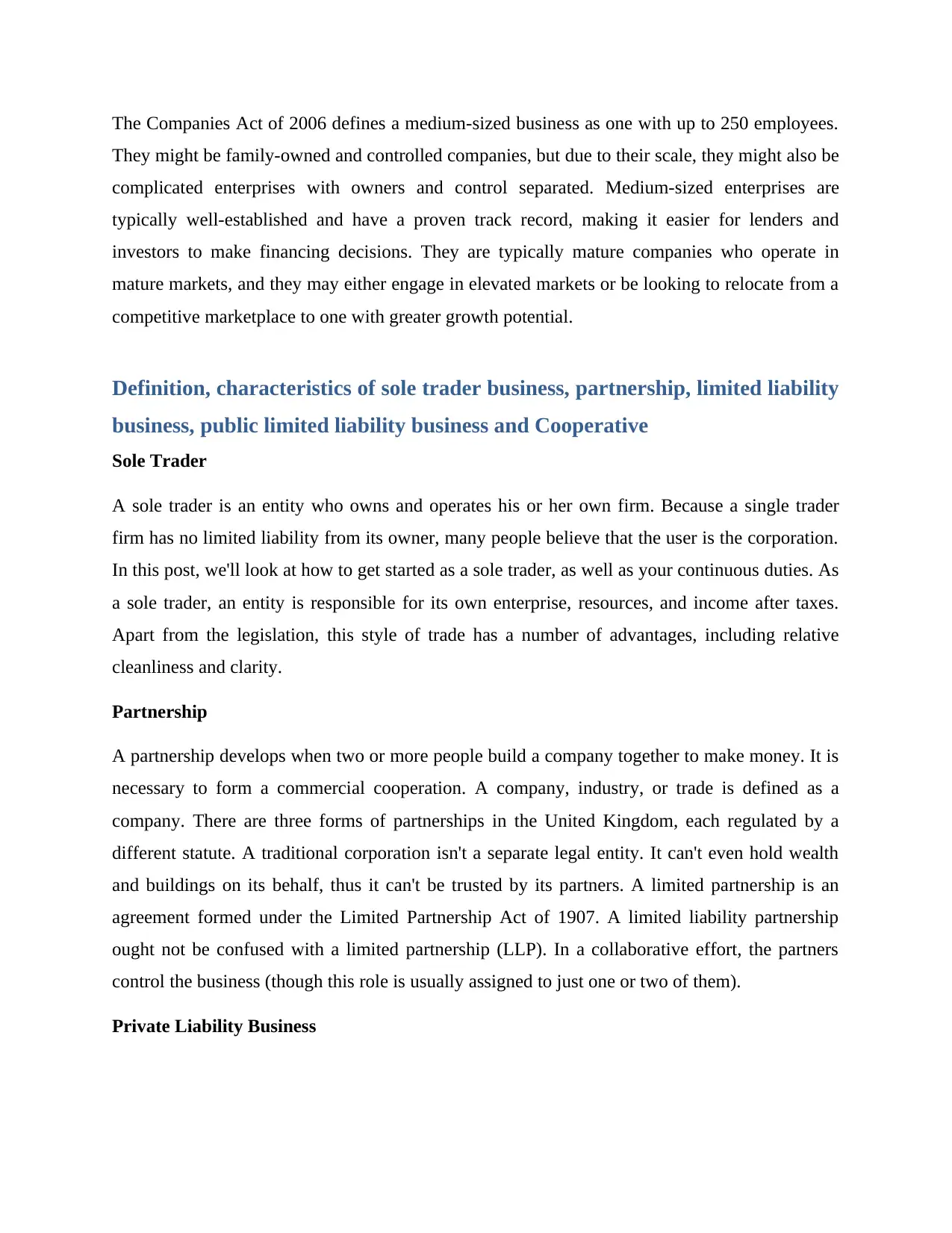
The Companies Act of 2006 defines a medium-sized business as one with up to 250 employees.
They might be family-owned and controlled companies, but due to their scale, they might also be
complicated enterprises with owners and control separated. Medium-sized enterprises are
typically well-established and have a proven track record, making it easier for lenders and
investors to make financing decisions. They are typically mature companies who operate in
mature markets, and they may either engage in elevated markets or be looking to relocate from a
competitive marketplace to one with greater growth potential.
Definition, characteristics of sole trader business, partnership, limited liability
business, public limited liability business and Cooperative
Sole Trader
A sole trader is an entity who owns and operates his or her own firm. Because a single trader
firm has no limited liability from its owner, many people believe that the user is the corporation.
In this post, we'll look at how to get started as a sole trader, as well as your continuous duties. As
a sole trader, an entity is responsible for its own enterprise, resources, and income after taxes.
Apart from the legislation, this style of trade has a number of advantages, including relative
cleanliness and clarity.
Partnership
A partnership develops when two or more people build a company together to make money. It is
necessary to form a commercial cooperation. A company, industry, or trade is defined as a
company. There are three forms of partnerships in the United Kingdom, each regulated by a
different statute. A traditional corporation isn't a separate legal entity. It can't even hold wealth
and buildings on its behalf, thus it can't be trusted by its partners. A limited partnership is an
agreement formed under the Limited Partnership Act of 1907. A limited liability partnership
ought not be confused with a limited partnership (LLP). In a collaborative effort, the partners
control the business (though this role is usually assigned to just one or two of them).
Private Liability Business
They might be family-owned and controlled companies, but due to their scale, they might also be
complicated enterprises with owners and control separated. Medium-sized enterprises are
typically well-established and have a proven track record, making it easier for lenders and
investors to make financing decisions. They are typically mature companies who operate in
mature markets, and they may either engage in elevated markets or be looking to relocate from a
competitive marketplace to one with greater growth potential.
Definition, characteristics of sole trader business, partnership, limited liability
business, public limited liability business and Cooperative
Sole Trader
A sole trader is an entity who owns and operates his or her own firm. Because a single trader
firm has no limited liability from its owner, many people believe that the user is the corporation.
In this post, we'll look at how to get started as a sole trader, as well as your continuous duties. As
a sole trader, an entity is responsible for its own enterprise, resources, and income after taxes.
Apart from the legislation, this style of trade has a number of advantages, including relative
cleanliness and clarity.
Partnership
A partnership develops when two or more people build a company together to make money. It is
necessary to form a commercial cooperation. A company, industry, or trade is defined as a
company. There are three forms of partnerships in the United Kingdom, each regulated by a
different statute. A traditional corporation isn't a separate legal entity. It can't even hold wealth
and buildings on its behalf, thus it can't be trusted by its partners. A limited partnership is an
agreement formed under the Limited Partnership Act of 1907. A limited liability partnership
ought not be confused with a limited partnership (LLP). In a collaborative effort, the partners
control the business (though this role is usually assigned to just one or two of them).
Private Liability Business
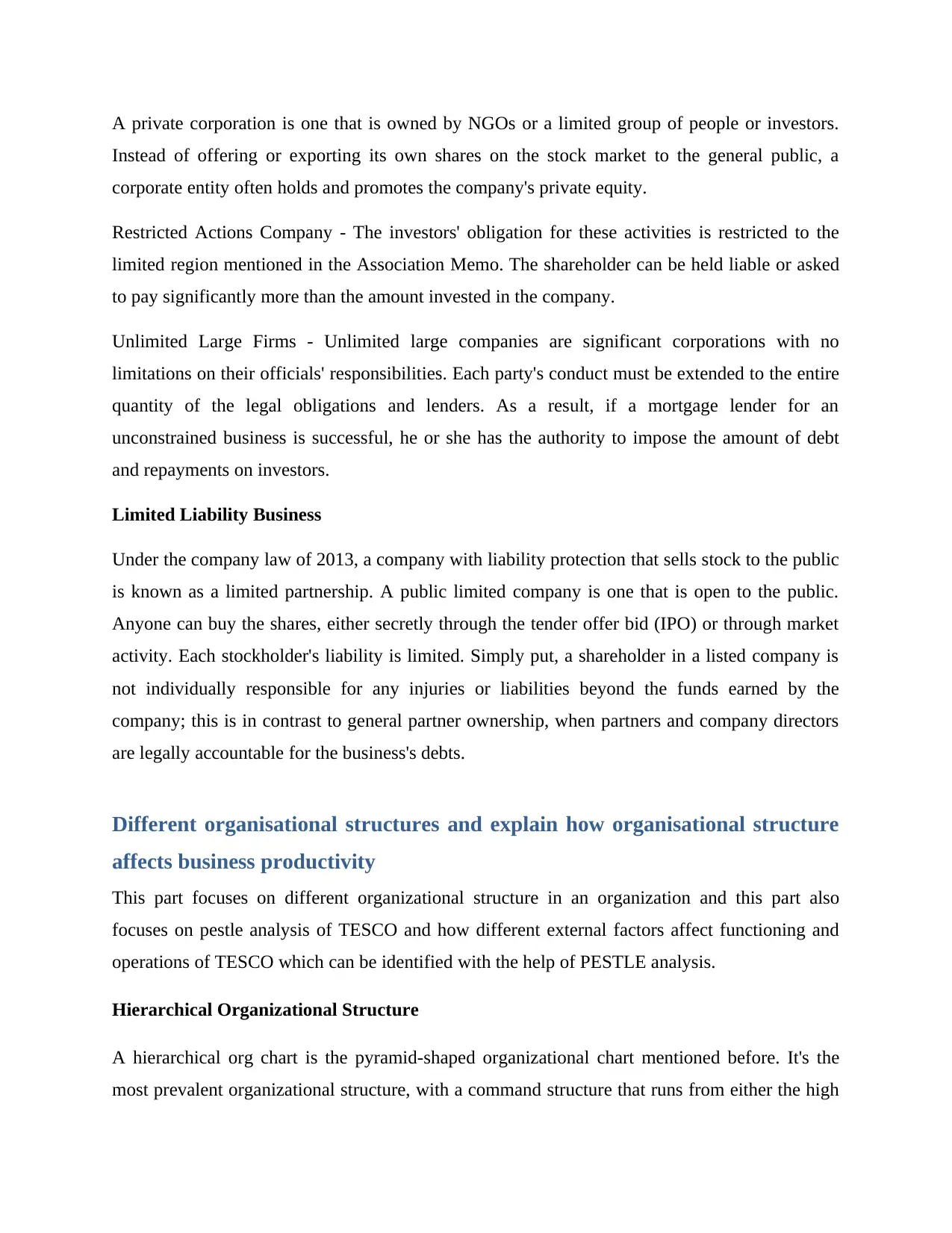
A private corporation is one that is owned by NGOs or a limited group of people or investors.
Instead of offering or exporting its own shares on the stock market to the general public, a
corporate entity often holds and promotes the company's private equity.
Restricted Actions Company - The investors' obligation for these activities is restricted to the
limited region mentioned in the Association Memo. The shareholder can be held liable or asked
to pay significantly more than the amount invested in the company.
Unlimited Large Firms - Unlimited large companies are significant corporations with no
limitations on their officials' responsibilities. Each party's conduct must be extended to the entire
quantity of the legal obligations and lenders. As a result, if a mortgage lender for an
unconstrained business is successful, he or she has the authority to impose the amount of debt
and repayments on investors.
Limited Liability Business
Under the company law of 2013, a company with liability protection that sells stock to the public
is known as a limited partnership. A public limited company is one that is open to the public.
Anyone can buy the shares, either secretly through the tender offer bid (IPO) or through market
activity. Each stockholder's liability is limited. Simply put, a shareholder in a listed company is
not individually responsible for any injuries or liabilities beyond the funds earned by the
company; this is in contrast to general partner ownership, when partners and company directors
are legally accountable for the business's debts.
Different organisational structures and explain how organisational structure
affects business productivity
This part focuses on different organizational structure in an organization and this part also
focuses on pestle analysis of TESCO and how different external factors affect functioning and
operations of TESCO which can be identified with the help of PESTLE analysis.
Hierarchical Organizational Structure
A hierarchical org chart is the pyramid-shaped organizational chart mentioned before. It's the
most prevalent organizational structure, with a command structure that runs from either the high
Instead of offering or exporting its own shares on the stock market to the general public, a
corporate entity often holds and promotes the company's private equity.
Restricted Actions Company - The investors' obligation for these activities is restricted to the
limited region mentioned in the Association Memo. The shareholder can be held liable or asked
to pay significantly more than the amount invested in the company.
Unlimited Large Firms - Unlimited large companies are significant corporations with no
limitations on their officials' responsibilities. Each party's conduct must be extended to the entire
quantity of the legal obligations and lenders. As a result, if a mortgage lender for an
unconstrained business is successful, he or she has the authority to impose the amount of debt
and repayments on investors.
Limited Liability Business
Under the company law of 2013, a company with liability protection that sells stock to the public
is known as a limited partnership. A public limited company is one that is open to the public.
Anyone can buy the shares, either secretly through the tender offer bid (IPO) or through market
activity. Each stockholder's liability is limited. Simply put, a shareholder in a listed company is
not individually responsible for any injuries or liabilities beyond the funds earned by the
company; this is in contrast to general partner ownership, when partners and company directors
are legally accountable for the business's debts.
Different organisational structures and explain how organisational structure
affects business productivity
This part focuses on different organizational structure in an organization and this part also
focuses on pestle analysis of TESCO and how different external factors affect functioning and
operations of TESCO which can be identified with the help of PESTLE analysis.
Hierarchical Organizational Structure
A hierarchical org chart is the pyramid-shaped organizational chart mentioned before. It's the
most prevalent organizational structure, with a command structure that runs from either the high
⊘ This is a preview!⊘
Do you want full access?
Subscribe today to unlock all pages.

Trusted by 1+ million students worldwide
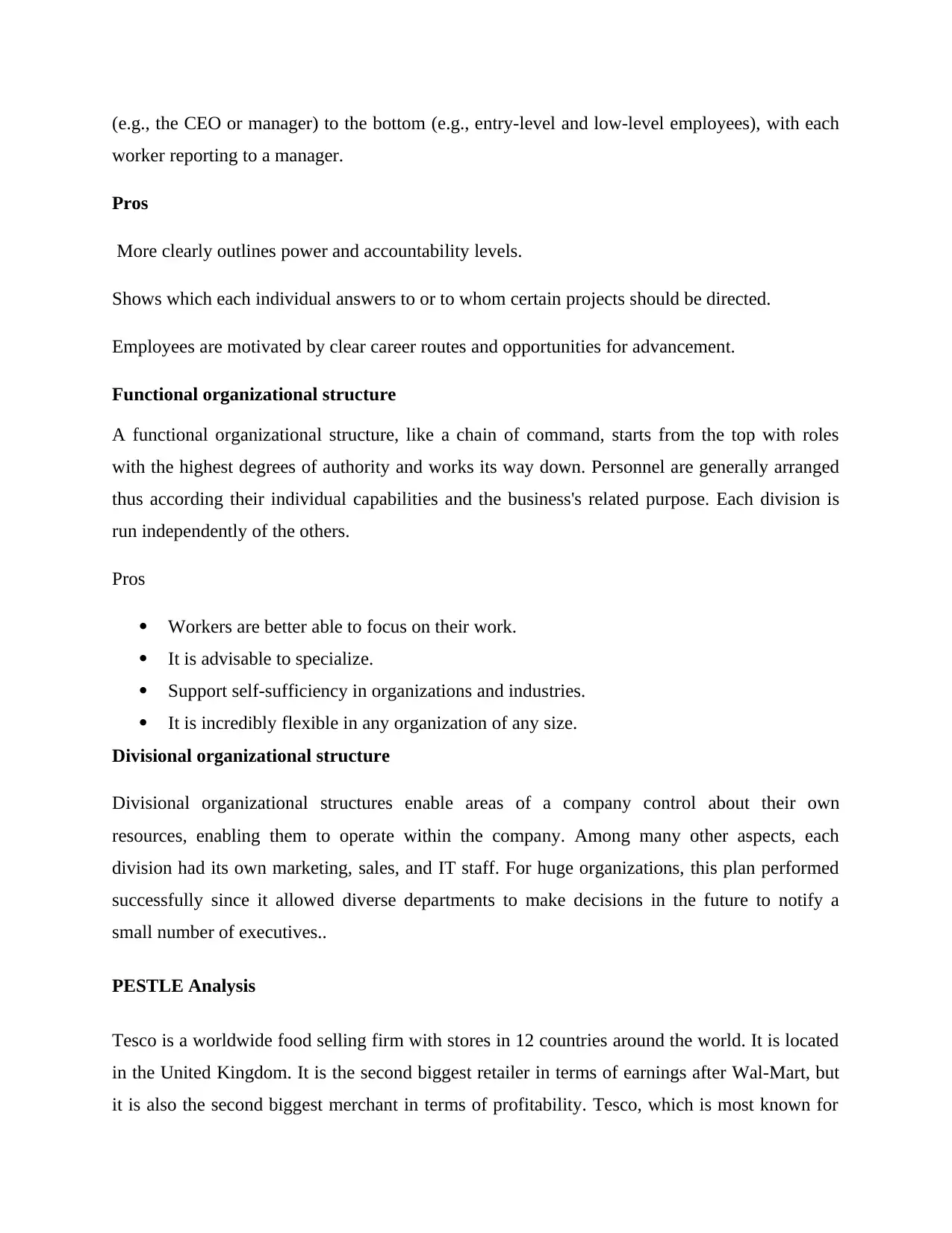
(e.g., the CEO or manager) to the bottom (e.g., entry-level and low-level employees), with each
worker reporting to a manager.
Pros
More clearly outlines power and accountability levels.
Shows which each individual answers to or to whom certain projects should be directed.
Employees are motivated by clear career routes and opportunities for advancement.
Functional organizational structure
A functional organizational structure, like a chain of command, starts from the top with roles
with the highest degrees of authority and works its way down. Personnel are generally arranged
thus according their individual capabilities and the business's related purpose. Each division is
run independently of the others.
Pros
Workers are better able to focus on their work.
It is advisable to specialize.
Support self-sufficiency in organizations and industries.
It is incredibly flexible in any organization of any size.
Divisional organizational structure
Divisional organizational structures enable areas of a company control about their own
resources, enabling them to operate within the company. Among many other aspects, each
division had its own marketing, sales, and IT staff. For huge organizations, this plan performed
successfully since it allowed diverse departments to make decisions in the future to notify a
small number of executives..
PESTLE Analysis
Tesco is a worldwide food selling firm with stores in 12 countries around the world. It is located
in the United Kingdom. It is the second biggest retailer in terms of earnings after Wal-Mart, but
it is also the second biggest merchant in terms of profitability. Tesco, which is most known for
worker reporting to a manager.
Pros
More clearly outlines power and accountability levels.
Shows which each individual answers to or to whom certain projects should be directed.
Employees are motivated by clear career routes and opportunities for advancement.
Functional organizational structure
A functional organizational structure, like a chain of command, starts from the top with roles
with the highest degrees of authority and works its way down. Personnel are generally arranged
thus according their individual capabilities and the business's related purpose. Each division is
run independently of the others.
Pros
Workers are better able to focus on their work.
It is advisable to specialize.
Support self-sufficiency in organizations and industries.
It is incredibly flexible in any organization of any size.
Divisional organizational structure
Divisional organizational structures enable areas of a company control about their own
resources, enabling them to operate within the company. Among many other aspects, each
division had its own marketing, sales, and IT staff. For huge organizations, this plan performed
successfully since it allowed diverse departments to make decisions in the future to notify a
small number of executives..
PESTLE Analysis
Tesco is a worldwide food selling firm with stores in 12 countries around the world. It is located
in the United Kingdom. It is the second biggest retailer in terms of earnings after Wal-Mart, but
it is also the second biggest merchant in terms of profitability. Tesco, which is most known for
Paraphrase This Document
Need a fresh take? Get an instant paraphrase of this document with our AI Paraphraser
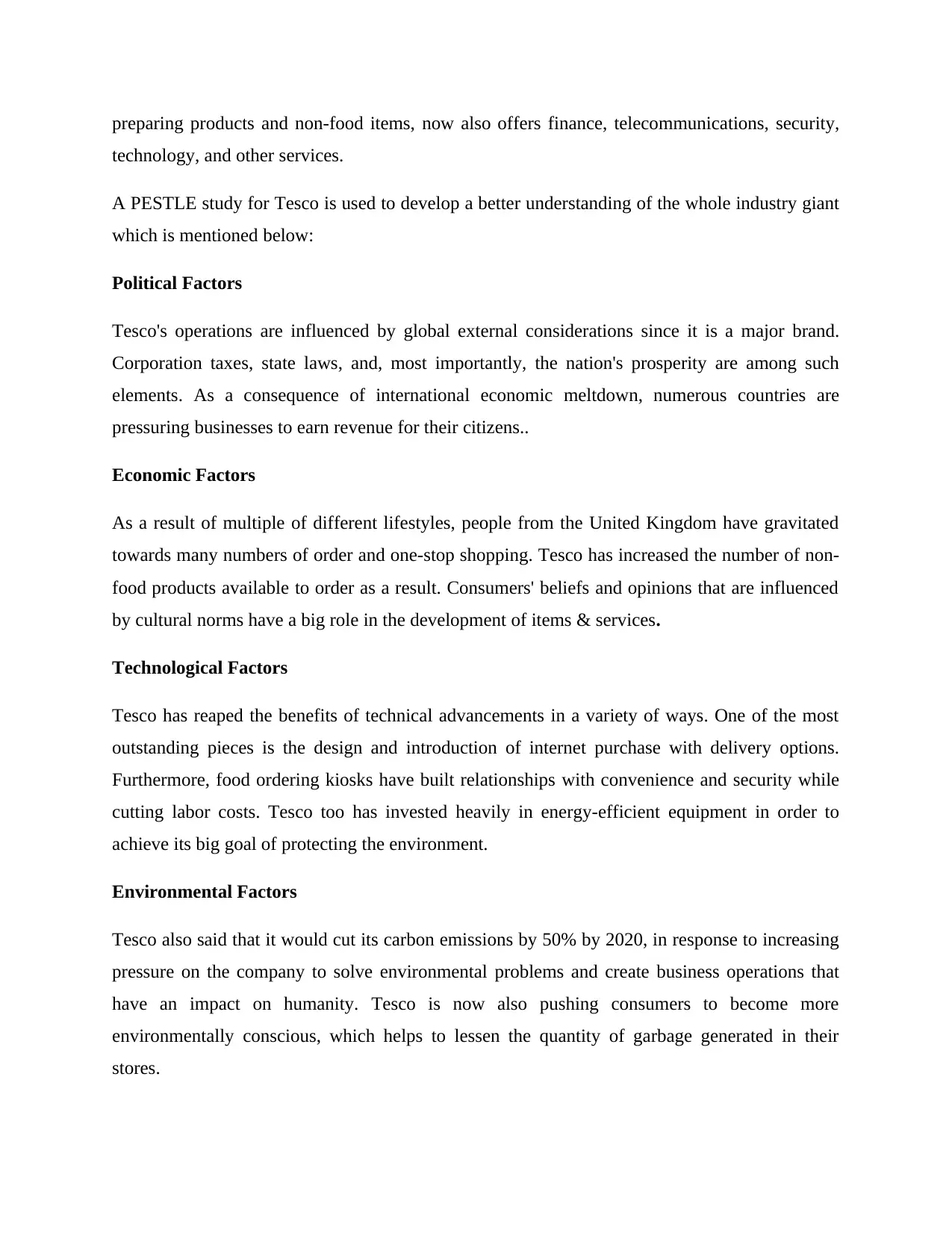
preparing products and non-food items, now also offers finance, telecommunications, security,
technology, and other services.
A PESTLE study for Tesco is used to develop a better understanding of the whole industry giant
which is mentioned below:
Political Factors
Tesco's operations are influenced by global external considerations since it is a major brand.
Corporation taxes, state laws, and, most importantly, the nation's prosperity are among such
elements. As a consequence of international economic meltdown, numerous countries are
pressuring businesses to earn revenue for their citizens..
Economic Factors
As a result of multiple of different lifestyles, people from the United Kingdom have gravitated
towards many numbers of order and one-stop shopping. Tesco has increased the number of non-
food products available to order as a result. Consumers' beliefs and opinions that are influenced
by cultural norms have a big role in the development of items & services.
Technological Factors
Tesco has reaped the benefits of technical advancements in a variety of ways. One of the most
outstanding pieces is the design and introduction of internet purchase with delivery options.
Furthermore, food ordering kiosks have built relationships with convenience and security while
cutting labor costs. Tesco too has invested heavily in energy-efficient equipment in order to
achieve its big goal of protecting the environment.
Environmental Factors
Tesco also said that it would cut its carbon emissions by 50% by 2020, in response to increasing
pressure on the company to solve environmental problems and create business operations that
have an impact on humanity. Tesco is now also pushing consumers to become more
environmentally conscious, which helps to lessen the quantity of garbage generated in their
stores.
technology, and other services.
A PESTLE study for Tesco is used to develop a better understanding of the whole industry giant
which is mentioned below:
Political Factors
Tesco's operations are influenced by global external considerations since it is a major brand.
Corporation taxes, state laws, and, most importantly, the nation's prosperity are among such
elements. As a consequence of international economic meltdown, numerous countries are
pressuring businesses to earn revenue for their citizens..
Economic Factors
As a result of multiple of different lifestyles, people from the United Kingdom have gravitated
towards many numbers of order and one-stop shopping. Tesco has increased the number of non-
food products available to order as a result. Consumers' beliefs and opinions that are influenced
by cultural norms have a big role in the development of items & services.
Technological Factors
Tesco has reaped the benefits of technical advancements in a variety of ways. One of the most
outstanding pieces is the design and introduction of internet purchase with delivery options.
Furthermore, food ordering kiosks have built relationships with convenience and security while
cutting labor costs. Tesco too has invested heavily in energy-efficient equipment in order to
achieve its big goal of protecting the environment.
Environmental Factors
Tesco also said that it would cut its carbon emissions by 50% by 2020, in response to increasing
pressure on the company to solve environmental problems and create business operations that
have an impact on humanity. Tesco is now also pushing consumers to become more
environmentally conscious, which helps to lessen the quantity of garbage generated in their
stores.
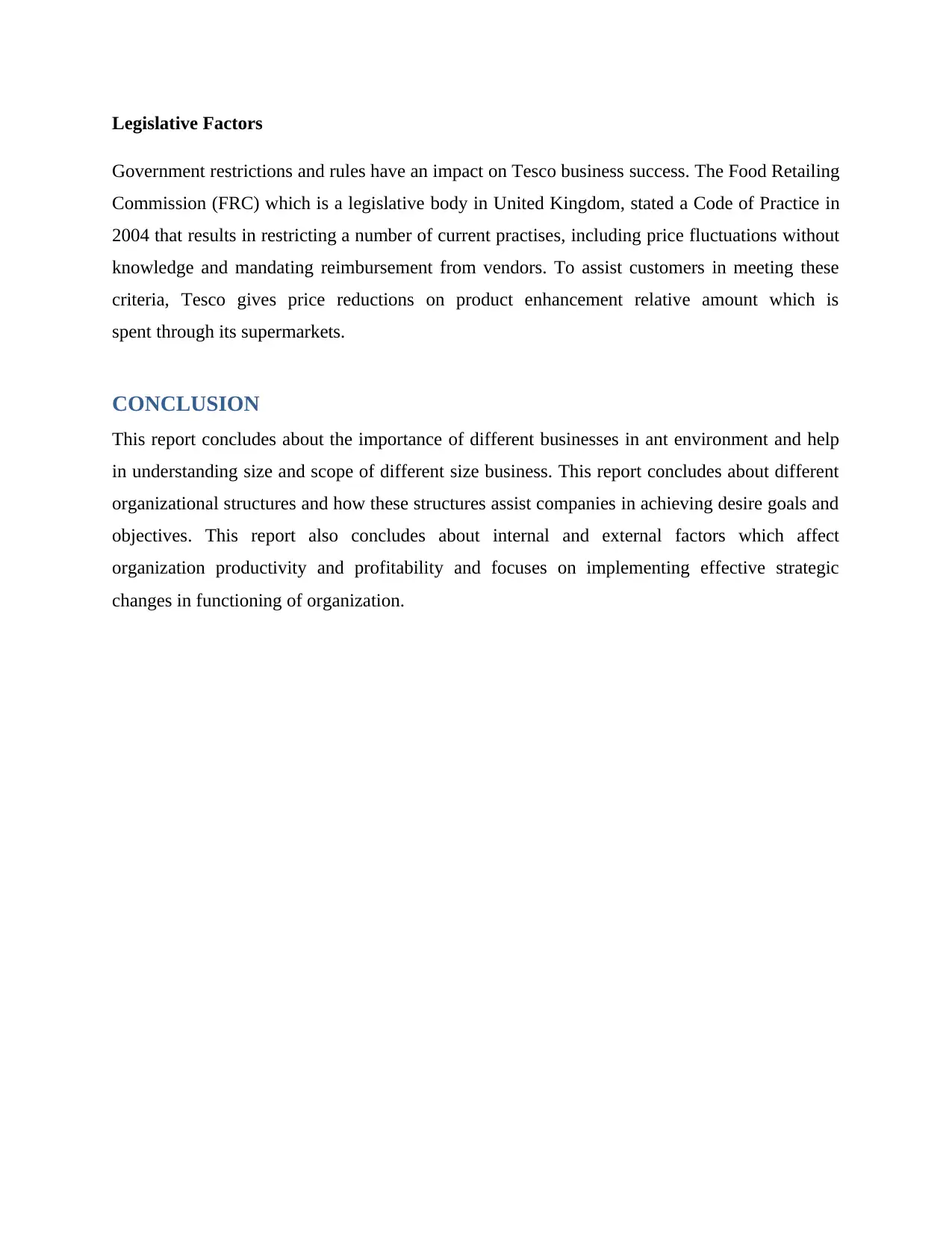
Legislative Factors
Government restrictions and rules have an impact on Tesco business success. The Food Retailing
Commission (FRC) which is a legislative body in United Kingdom, stated a Code of Practice in
2004 that results in restricting a number of current practises, including price fluctuations without
knowledge and mandating reimbursement from vendors. To assist customers in meeting these
criteria, Tesco gives price reductions on product enhancement relative amount which is
spent through its supermarkets.
CONCLUSION
This report concludes about the importance of different businesses in ant environment and help
in understanding size and scope of different size business. This report concludes about different
organizational structures and how these structures assist companies in achieving desire goals and
objectives. This report also concludes about internal and external factors which affect
organization productivity and profitability and focuses on implementing effective strategic
changes in functioning of organization.
Government restrictions and rules have an impact on Tesco business success. The Food Retailing
Commission (FRC) which is a legislative body in United Kingdom, stated a Code of Practice in
2004 that results in restricting a number of current practises, including price fluctuations without
knowledge and mandating reimbursement from vendors. To assist customers in meeting these
criteria, Tesco gives price reductions on product enhancement relative amount which is
spent through its supermarkets.
CONCLUSION
This report concludes about the importance of different businesses in ant environment and help
in understanding size and scope of different size business. This report concludes about different
organizational structures and how these structures assist companies in achieving desire goals and
objectives. This report also concludes about internal and external factors which affect
organization productivity and profitability and focuses on implementing effective strategic
changes in functioning of organization.
⊘ This is a preview!⊘
Do you want full access?
Subscribe today to unlock all pages.

Trusted by 1+ million students worldwide
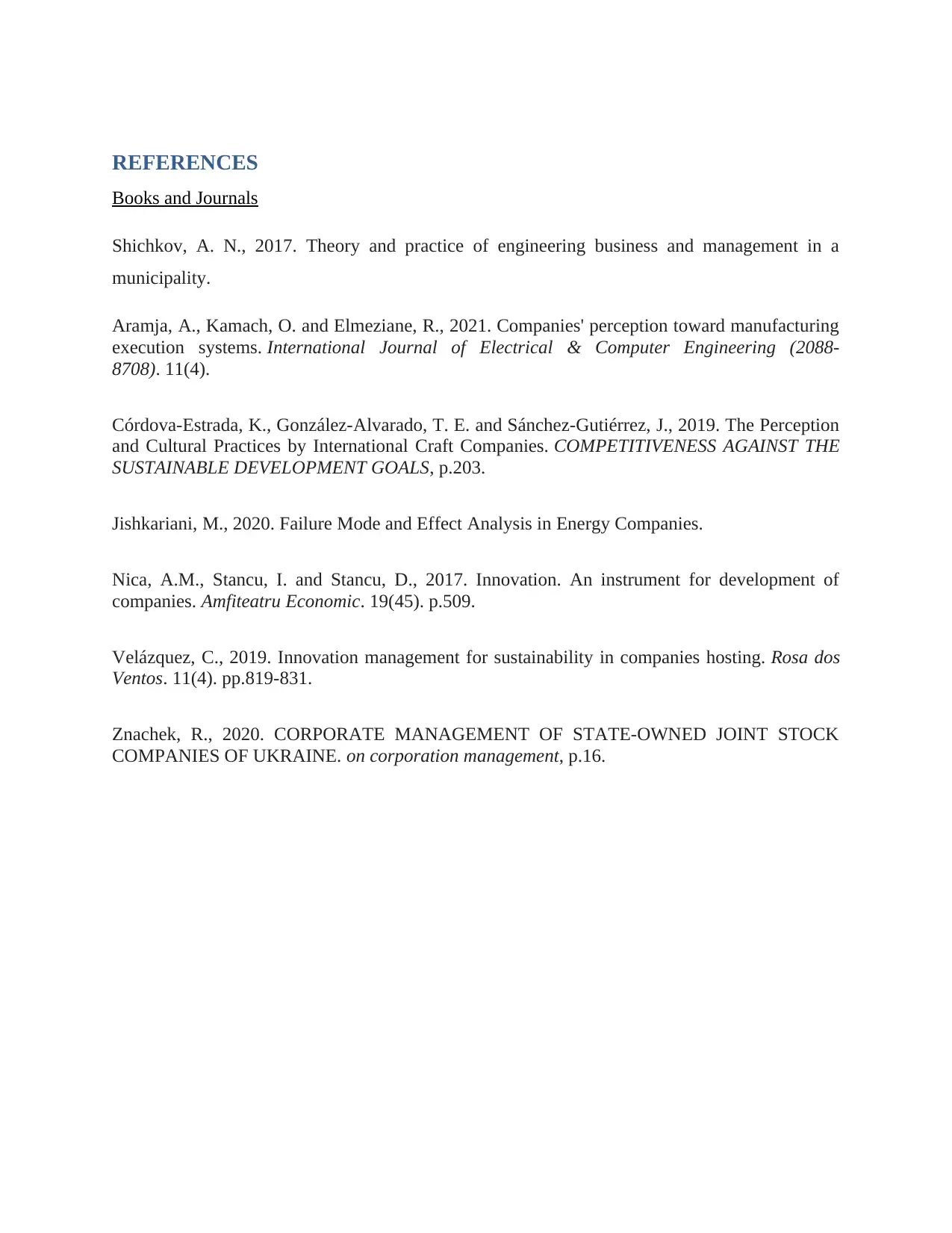
REFERENCES
Books and Journals
Shichkov, A. N., 2017. Theory and practice of engineering business and management in a
municipality.
Aramja, A., Kamach, O. and Elmeziane, R., 2021. Companies' perception toward manufacturing
execution systems. International Journal of Electrical & Computer Engineering (2088-
8708). 11(4).
Córdova-Estrada, K., González-Alvarado, T. E. and Sánchez-Gutiérrez, J., 2019. The Perception
and Cultural Practices by International Craft Companies. COMPETITIVENESS AGAINST THE
SUSTAINABLE DEVELOPMENT GOALS, p.203.
Jishkariani, M., 2020. Failure Mode and Effect Analysis in Energy Companies.
Nica, A.M., Stancu, I. and Stancu, D., 2017. Innovation. An instrument for development of
companies. Amfiteatru Economic. 19(45). p.509.
Velázquez, C., 2019. Innovation management for sustainability in companies hosting. Rosa dos
Ventos. 11(4). pp.819-831.
Znachek, R., 2020. CORPORATE MANAGEMENT OF STATE-OWNED JOINT STOCK
COMPANIES OF UKRAINE. on corporation management, p.16.
Books and Journals
Shichkov, A. N., 2017. Theory and practice of engineering business and management in a
municipality.
Aramja, A., Kamach, O. and Elmeziane, R., 2021. Companies' perception toward manufacturing
execution systems. International Journal of Electrical & Computer Engineering (2088-
8708). 11(4).
Córdova-Estrada, K., González-Alvarado, T. E. and Sánchez-Gutiérrez, J., 2019. The Perception
and Cultural Practices by International Craft Companies. COMPETITIVENESS AGAINST THE
SUSTAINABLE DEVELOPMENT GOALS, p.203.
Jishkariani, M., 2020. Failure Mode and Effect Analysis in Energy Companies.
Nica, A.M., Stancu, I. and Stancu, D., 2017. Innovation. An instrument for development of
companies. Amfiteatru Economic. 19(45). p.509.
Velázquez, C., 2019. Innovation management for sustainability in companies hosting. Rosa dos
Ventos. 11(4). pp.819-831.
Znachek, R., 2020. CORPORATE MANAGEMENT OF STATE-OWNED JOINT STOCK
COMPANIES OF UKRAINE. on corporation management, p.16.
Paraphrase This Document
Need a fresh take? Get an instant paraphrase of this document with our AI Paraphraser

1 out of 11
Related Documents
Your All-in-One AI-Powered Toolkit for Academic Success.
+13062052269
info@desklib.com
Available 24*7 on WhatsApp / Email
![[object Object]](/_next/static/media/star-bottom.7253800d.svg)
Unlock your academic potential
Copyright © 2020–2025 A2Z Services. All Rights Reserved. Developed and managed by ZUCOL.




